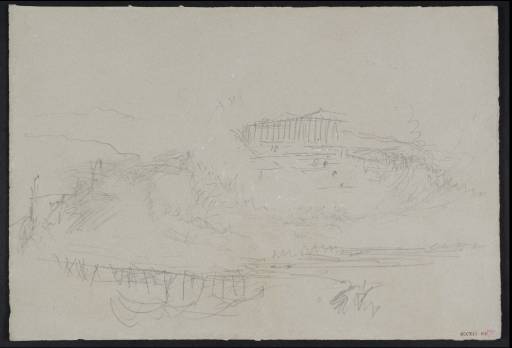Joseph Mallord William Turner St Salvator's Pilgrimage Church and the Walhalla, across the River Danube at Donaustauf near Regensburg 1840
Joseph Mallord William Turner,
St Salvator's Pilgrimage Church and the Walhalla, across the River Danube at Donaustauf near Regensburg
1840
Joseph Mallord William Turner 1775–1851
St Salvator’s Pilgrimage Church and the Walhalla, across the River Danube at Donaustauf near Regensburg 1840
D34093
Turner Bequest CCCXLI 371
Turner Bequest CCCXLI 371
Chalk and pencil on grey wove paper, 191 x 280 mm
Blind-stamped with Turner Bequest monogram towards bottom right
Inscribed by Turner in pencil ‘18’ and ‘8’ above right of centre, below columns
Inscribed in red ink ‘371’ bottom right (now faint)
Stamped in black ‘CCCXLI – 371’ bottom right
Blind-stamped with Turner Bequest monogram towards bottom right
Inscribed by Turner in pencil ‘18’ and ‘8’ above right of centre, below columns
Inscribed in red ink ‘371’ bottom right (now faint)
Stamped in black ‘CCCXLI – 371’ bottom right
Accepted by the nation as part of the Turner Bequest 1856
Exhibition history
1999
Turner’s Later Papers: A Study of the Manufacture, Selection and Use of his Drawing Papers 1820–1851, Tate Gallery, London, March–June 1999 (59, as part of ‘Reassembled sheet made up of seven different works with views of Regensburg and the Walhalla’, 1840, reproduced).
References
1830
A.J. Finberg, A Complete Inventory of the Drawings of the Turner Bequest, London 1909, vol.II, p.1088, CCCXLI 371, as ‘The Walhalla, near Ratisbon, on the Danube’, c.1830–41.
1995
Cecilia Powell, Turner in Germany, exhibition catalogue, Tate Gallery, London 1995, pp.70, 82 note 53, 168 under nos.96 and 97.
1999
Peter Bower, Turner’s Later Papers: A Study of the Manufacture, Selection and Use of his Drawing Papers 1820–1851, exhibition catalogue, Tate Gallery, London 1999, pp.105, 107 no.59, as part of ‘Reassembled sheet made up of seven different works with views of Regensburg and the Walhalla’, 1840, reproduced p.106.
2001
Cecilia Powell, ‘Walhalla’ in Evelyn Joll, Martin Butlin and Luke Herrmann eds., The Oxford Companion to J.M.W. Turner, Oxford 2001, p.370.
Turner visited Donaustauf, on the north bank of the River Danube about five miles east of Regensburg in southern Germany, to see the Greek temple-style Walhalla monument (as identified by Finberg1), then nearing completion ahead of its opening in 1842. He made numerous complementary pencil drawings in the vicinity in the Venice, Passau to Würzburg book; see under Tate D31341 (Turner Bequest CCCX 33a) for further details.2 Here, the somewhat frenetic pencil work shows the small pilgrimage church of St Salvator above the river on the left, with the Walhalla to its east on its tiered stone infrastructure; compare Tate D31342, D31356, D31358, D31360 and D31362 (CCCX 34, 41, 42, 43, 44) in the sketchbook. These sketches informed the major oil painting of The Opening of the Wallhalla [sic], 1842 (Tate N00533),3 exhibited at the Royal Academy in 1843 and in Munich in 1845.
As discussed in the technical notes below, the present study is one of seven of Regensburg and the nearby Walhalla at Donaustauf (see also Tate D32185, D34081, D34084–D34085, D36150, D36153; Turner Bequest CCCXVII 6, CCCXLI 360, 363, 364, CCCLXIV 293, 296) which were initially eighths of a single sheet; D36151 (CCCLXIV 294) is a related view on similar paper. Of these, D34084 shows the interior of the Walhalla while D34085 is a similar landscape view including the town, out of sight to the left here. See also a watercolour study on conventional white paper (Tate D36174; Turner Bequest CCCLXIV 316).
Technical notes:
The spots of white chalk scattered across the middle of the drawing do not appear to relate to the pencil work, and may be adventitious or offset directly from another sheet; compare the more extensive and purposeful highlighting in the two Walhalla drawings mentioned above (D34084–D34085; CCCXLI 363, 364).
Among many such works on the blue or grey papers customarily used by Turner, this is one of seven originally from a single piece (subsequently scattered through Finberg’s 1909 Inventory, as listed above) to be identified by Cecilia Powell as showing subjects in and around Regensburg.1 They are from an 1829 sheet of the grey Bally, Ellen and Steart paper often used in 1840 (see the Introduction to the overall tour), and were temporarily reassembled for paper conservator Peter Bower’s 1999 Turner’s Later Papers exhibition, showing that their slightly irregular edges match exactly.2
Four subjects were drawn on one side, and three on the other, only one face of each eighth being used, with a last section unaccounted for. Bower has noted Turner’s habit of tearing such sheets, sometimes in advance or sometimes after making a sequence of sketches, unfolding and refolding the intact sheet as necessary.3 The delicate white chalk highlights on several, and the lively gouache and watercolour on three (noted in individual entries), was likely added once the sheets were separated, as suggested particularly by the colour having been freely worked up to the torn edges, with no sign of overlapping brushwork or adventitious splashes across originally neighbouring areas.
Verso:
Blank; inscribed in pencil ‘CCCXLI 371 | BOX 101’ bottom right.
Matthew Imms
September 2018
How to cite
Matthew Imms, ‘St Salvator’s Pilgrimage Church and the Walhalla, across the River Danube at Donaustauf near Regensburg 1840 by Joseph Mallord William Turner’, catalogue entry, September 2018, in David Blayney Brown (ed.), J.M.W. Turner: Sketchbooks, Drawings and Watercolours, Tate Research Publication, December 2019, https://www

